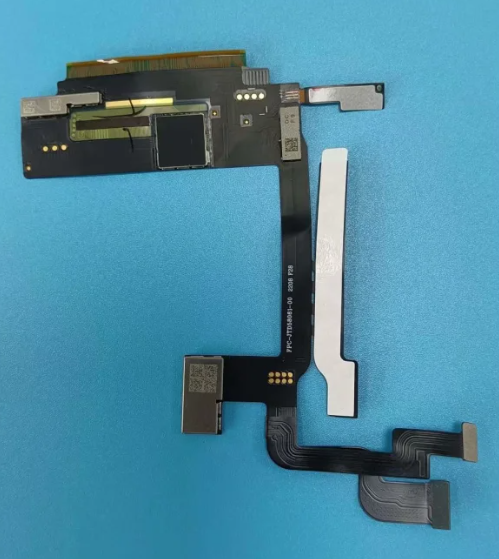Flexible Printed Circuit Board (Flex PCB) assembly refers to the process of manufacturing and assembling electronic circuits on flexible substrates rather than rigid ones like traditional printed circuit boards (PCBs). Flex PCBs are made from flexible materials such as polyimide (PI) or polyester (PET) and are ideal for applications where space constraints, weight reduction, and the ability to conform to complex shapes are important considerations.
The assembly of flex PCBs involves several steps:
- Design: The first step is to design the flex PCB layout, taking into account the specific requirements of the application. The design must consider the flexible nature of the substrate and any bending or folding that may be required.
- Material Selection: Choosing the appropriate flexible substrate material is crucial. Polyimide is a common choice due to its flexibility, thermal stability, and electrical insulation properties.
- Circuit Fabrication: The flexible substrate is coated with a layer of copper and then chemically etched to create the desired circuit pattern. This process is similar to the fabrication of rigid PCBs.
- Component Placement: Surface-mount components (SMD) and through-hole components may be mounted onto the flex PCB using soldering techniques. Special considerations are necessary for components that will be subjected to flexing or bending.
- Soldering: Soldering can be performed using reflow soldering, wave soldering, or other soldering techniques depending on the components and design.
- Testing: Rigorous testing is essential to ensure the reliability of the flex PCB assembly. This may include electrical testing, continuity checks, and functional testing.
- Encapsulation: Depending on the application, the flex PCB assembly may be encapsulated in a protective layer or conformal coating to shield it from environmental factors such as moisture, dust, and chemicals.
- Inspection: Quality control and inspection processes are carried out to check for any defects or issues in the assembly.
Flex PCB assemblies are commonly used in various industries, including aerospace, automotive, medical devices, consumer electronics, and more. They offer advantages such as reduced weight, improved flexibility, and the ability to fit into tight spaces, making them suitable for applications where traditional rigid PCBs are not practical.
What are the difficulties with the flex PCB assembly?
Flex PCB assembly presents several unique challenges and difficulties compared to the assembly of rigid printed circuit boards (PCBs). Some of the key difficulties associated with flex PCB assembly include:
- Material Flexibility: The flexible nature of the substrate can make handling and assembly more complex. It requires special care to prevent damage during the assembly process, especially when dealing with thin and delicate materials.
- Component Placement and Alignment: Components must be accurately placed and aligned on the flexible substrate. The substrate’s flexibility can make it challenging to maintain precise component positions, especially for fine-pitch surface-mount components.
- Soldering and Heat Management: Soldering on a flexible substrate requires careful consideration of temperature profiles. Overheating can cause the substrate to deform or delaminate, leading to electrical and mechanical issues. Specialized soldering techniques and equipment may be needed.
- Bending and Flexing: Flex PCBs are designed to bend and flex, but this creates additional challenges in ensuring that components and solder joints can withstand repeated bending without failure. It’s essential to choose components and solder materials that can tolerate flexing.
- Rigid-Flex Integration: In some applications, flex PCBs are integrated with rigid PCBs. Ensuring a reliable connection between the two can be complex, as it involves transitioning from the flexible to the rigid part of the assembly.
- Testing and Inspection: Testing flex PCB assemblies can be more challenging due to their flexible nature. Specialized testing equipment may be required to assess electrical connectivity, and functional testing should account for the flexing characteristics.
- Design Complexity: Designing flexible circuits can be more complex than rigid PCBs, as it requires careful consideration of bend radii, strain relief, and the mechanical properties of the materials. Design errors can lead to premature failure during flexing.
- Environmental Factors: Flex PCBs may be used in environments with high levels of moisture, temperature variations, or chemical exposure. Proper encapsulation and conformal coating are crucial to protect the assembly from these factors.
- Cost: The materials and processes involved in flex PCB assembly can be more expensive than traditional rigid PCBs. Additionally, repairing or reworking flex PCBs can be challenging and costly.
- Specialized Equipment and Expertise: Working with flex PCBs may require specialized equipment and expertise. Not all PCB assembly facilities may have the necessary tools and experience to handle flex PCBs effectively.
Despite these challenges, flex PCBs offer unique advantages in terms of flexibility, space-saving, and conformability, making them suitable for a wide range of applications. Successful flex PCB assembly requires careful planning, attention to detail, and a deep understanding of the specific requirements and constraints of the project.

